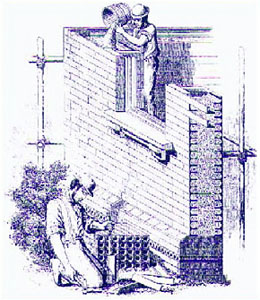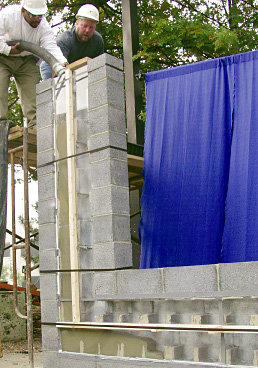High, Low and In-between: An Update on Grout for Masonry
By Jamie Farny

Grouted, reinforced masonry greatly expands the structural capabilities of masonry construction. It opens the door to applications that would not be possible with traditional unreinforced masonry. These include taller, thinner masonry walls and structural applications in regions subject to high winds and seismic activity.
Grouted, reinforced masonry is not new in the United States. Its history here dates back to the mid-1800s, as depicted in the image at right, and it continues to be popular in all parts of the country. It has been used for high-rise buildings, but it is more commonly used for single-story and low-rise construction.
The concept is simple: masonry walls are constructed and steel bars are placed in certain horizontal and/or vertical cores, which are then filled with grout, often by pumping. Masonry units are made from concrete or clay, though concrete units are more common for this application. The grout is a fluid mixture of cement, aggregates and water. It is specified per ASTM C 476, Specification for Grout for Masonry. Slump of conventional grout is between eight inches and 11 inches to give the material adequate workability to be placed. The grout ties the elements together, in effect creating a reinforced concrete structure.
Walls can contain columns (i.e., piers) and beams of grout (i.e., bond beams) - referred to as partial grouting - or can be solidly grouted. Not only is grouted masonry an efficient system, it's easy to accommodate the amount of reinforcement needed to strengthen the wall as desired. Limiting grout placement time to 1-1/2 hours or less assures that cement hydration has not advanced too far when grouting occurs, thus making it possible to place grout in the cores so it can properly bond to both the masonry units and reinforcement.

Building Better, Cheaper, Faster
That old construction rule states that you can choose one thing to optimize, maybe two, but to go for all three - better, cheaper and faster - you are asking for a lot. For instance, if you want something built better and faster, you can probably expect to pay more. But that rule doesn't always apply; due to innovations and advancements in materials and construction methods, grouted masonry may be one of the few exceptions.
There are several trends in grouted, reinforced masonry that are making the system even more appealing to masons, designers and building owners. These include both material trends and installation trends. Ultimately, this will mean that reinforced masonry can be built faster, with less equipment, or with better control over the quality of the completed construction.
Self-consolidating Grout
One of the most exciting new areas is the advent of self-consolidating grout (SCG). This is an offshoot of the self-consolidating concrete industry. Using new grout formulations incorporating a newer class of chemical admixtures called polycarboxylates develops very fluid, but stable, mixes. These materials can make a cementitious mixture have a flowing consistency. For the tight spaces where grout is required to flow, these mixes have a distinct advantage. Not only do they get where they need to be, they require no vibration to do so.

Another potential advantage of SCG is that it's easier to place the material - walls can be grouted faster and/or with smaller crews. In conventional grouting, grout is placed into the cores and then vibrated to consolidate it. In fact, assuring that grout has filled the cores of the block is one of the most important inspection items in conventional grouting. The already constricted core space contains reinforcement, and grout has to completely fill this space as it embeds the reinforcement. Compared to traditional grout, a fluid material like SCG can more easily accomplish those objectives.
As a new type of product, SCG is being studied to learn about its behavior in anticipation of its introduction to building codes. The National Concrete Masonry Association (NCMA) is conducting research into both fresh and hardened properties of the material to ensure satisfactory performance.
In all, SCG formulations, with the promise of saving construction time or reducing labor, offer an opportunity to make masonry an even more competitive building system.
The Highs and Lows of Grouting
Grouting techniques have been developed to ensure that walls are completely grouted. Section 1.16.1 of the 2005 Masonry Standards Joint Committee (MSJC) Code outlines provisions for the designer. Low- and high-lift grouting are both traditional grouting methods, with the difference being the height of lift. Lifts five feet or less are considered low lift, while lifts greater than five feet are considered to be high lift.
The MSJC Code and Specification previously limited builders to a maximum lift height of five feet for grout placement. In 2005, code developers introduced language allowing contractors to exceed that five-foot lift limitation. Article 3.5 of the MSJC Specification addresses grout placement, where it states that grout can be placed in lifts up to 12.67 feet tall, as long as the following three conditions are met:
- The masonry has cured for at least four hours (might need more time if the weather is cold);
- The grout slump is maintained between 10 and 11 inches; and
- The wall contains no intermediate bond beams between the top and bottom of the pour height.
For grout pours over five feet, cleanouts are also required. Cleanouts allow for the grout space to be cleaned prior to grouting and can be used to verify reinforcement placement.
Grout pours less than 12 inches can be consolidated by mechanical vibration or puddling, whereas grout pours greater than 12 inches have to be consolidated and reconsolidated by mechanical vibration. (It's important to note that a grout pour is composed of one or more lifts. So a grout pour is the total of all lifts placed in one operation.) Grout pour heights are given in Table 7 of the Specification and are based on grout type (fine or coarse), grout pour height, cavity width and size of core (cell).
In Article 3.5 F, a change introduced in 2002 permits alternate placement methods from those described here if they have been proven to be effective via a grout demonstration panel.
In a special case of low-lift grouting, some researchers are evaluating alternative techniques. One application of this has been for residential construction where builders construct an occasional bond beam. As the lift height is only a single course of concrete masonry, typically eight inches tall, the beam can be filled with material by hand. The fill material is high-strength mortar that has had water added to make it easier to place. Model building codes for residential construction such as the International Residential Code (IRC) have for years permitted the use of high-strength mortar as grout, as long as the mortar met certain criteria when mixed to a pouring consistency. Some have suggested that criteria for using mortar as grout should be considered for some commercial construction. The current research deals with evaluating the influence of mortar on its performance as grout in comparison to traditional low-lift grout placement materials and techniques. Mortar characteristics being evaluated are properties of the mixture itself, consistency and placement techniques.
Extended Set Grout
Extended set grouts have been available for quite some time. Where they can be especially useful are in harder-to-reach project locations where the truck may be hauling long distances to the site. While conventional grout must be placed within 1-1/2 hours from the time of introduction of water into the mix, extended set grouts incorporate chemical admixtures to delay the onset of hydration. In every other respect, these grouts are like conventional grouts once they are introduced into the cores of the masonry.
Specifying Grout
ASTM C 476 is the "go-to" document for grout. Grout is classified as either fine or coarse depending on the size of aggregate used. Allowable aggregate size is based on dimensions of the grout space to be filled and the height of space to be grouted. Grouts can be specified by proportions (a recipe) or by property. Proportion requirements are given in Table 1 of the standard. Alternately, specifiers can call for a compressive strength, using 2,000 psi as a minimum.
All grout types are specified by C 476. Because SCGs are relatively new, they currently are not a formal part of any standard. Once more is understood about their performance, such as through the NCMA research, it is anticipated that they will be incorporated into the C 476 standard.
Taking Another Look at Reinforced Masonry
Which grout formulation is right for your job? Some general considerations are outlined in the table below. Traditional grouts have proven themselves over many decades. Each grout formulation has some unique abilities, highlighted in the table here, which may be beneficial on a particular project.
| Traditional High-lift | Traditional Low-lift* | SCG | Traditional Extended Set | |
| Mixing | Plant or field | Plant or field | Plant | Plant |
| Location | All locations for field mixed; All locations, except remote, for plant mixed | All locations for field mixed; All locations, except remote, for plant mixed | All locations, except remote | Suited to remote or hard to reach locations, or for large volume placements |
| Labor/Crew | Standard | Standard | Smaller Crew | Standard |
| Consolidation | Required | Required | Not Required | Required |
| Reconsolidation | Required | Only required if lifts are greater than 12 inches | Not required | Only required if lifts are greater than 12 inches |
| Speed of Placement | Faster | Standard | Faster | Standard |
| Demonstration Panel | Recommended for pour heights over 12.67 ft** | Not Required | Most likely required | Not Required |
|
*The mortar-as-grout technique is not included here. **A grout pour height may be comprised of a single lift or multiple lifts (in a plastic condition). Note: Regarding placement, each of these grout types are placed with the same type of equipment, which includes large or small buckets and grout pumps. Contractor experience and grout volume affect the method of placing grout. |
||||
Masonry construction will continue to be valued for its aesthetics, durability, favorable construction schedule and versatility. The efforts being put forth on grout seem to indicate a healthy industry. Having so many different types of grout to choose from is good news for mason contractors. Grout, in its varied forms and with all its installation methods, offers many options for designers and builders to customize each project, while meeting or exceeding the owner's expectations.
References
Building Code Requirements for Masonry Structures, Specification for Masonry Structures, Commentary on Building Code Requirements for Masonry Structures, and Commentary on Specification for Masonry Structures, (ACI 530-05/ASCE 5-05/TMS 402-05 and ACI 530.1-05/ASCE 6-05/TMS 602-05), jointly published by the American Concrete Institute, American Society of Civil Engineers and The Masonry Society, Boulder, Colorado, 2005, 228 pages. (Available from Portland Cement Association as LT292.)
"Grout Goes Straight on Prison Project," and "Characteristics of Self-Consolidating Grout," Masonry Today Newsletter, PL386, Vol. 14, No. 2, Winter 2004/2005, Portland Cement Association, Skokie, Illinois, 2005, 4 pages. Free download at: http://www.cement.org/bookstore/profile.asp?store=&pagenum=1&pos=0&catID=&id=6176
Selecting and Specifying Mortar and Grout for Unit Masonry, IS275, Portland Cement Association, Skokie, Illinois, 1998, 8 pages.
About the Author
Jamie Farny is the Program Manager of Masonry and Special Products for the Portland Cement Association, coordinating research and promotion activities regarding cements for masonry and white cement. He participates on committees on concrete, plastering, mortars, and masonry units of the American Society for Testing and Materials and the American Concrete Institute. He holds a B.S. in Civil Engineering from the Illinois Institute of Technology.
All graphics courtesy of Portland Cement Association.


















